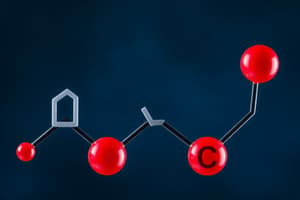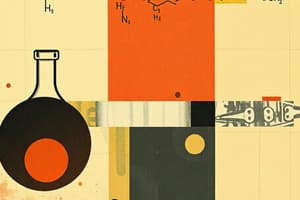Podcast
Questions and Answers
What is the result @ class of compound produce for the hydration reaction between propene and water with the presence of sulphuric acid?
What is the result @ class of compound produce for the hydration reaction between propene and water with the presence of sulphuric acid?
- Alcohol (correct)
- Alkane
- Aldehyde
- Carboxylic acid
Which catalytic conditions can promote the hydration of alkenes?
Which catalytic conditions can promote the hydration of alkenes?
- Sulphuric acid and hydrochloric acid
- Phosphoric acid and sulphuric acid (correct)
- Acetic acid and nickel
- Nitric acid and palladium on charcoal
What is the product formed during hydrogenation of an alkene?
What is the product formed during hydrogenation of an alkene?
- An alkyne
- An alkene
- An alcohol
- An alkane (correct)
Which catalyst can promote the hydrogenation reaction of alkenes?
Which catalyst can promote the hydrogenation reaction of alkenes?
What type of reaction is halogenation in organic chemistry?
What type of reaction is halogenation in organic chemistry?
What is a common chemical test used to differentiate between alkanes and alkenes?
What is a common chemical test used to differentiate between alkanes and alkenes?
Which reaction involves the addition of halogen on sp² hybridized carbons?
Which reaction involves the addition of halogen on sp² hybridized carbons?
Which test is the observation when alkenes undergoes reaction with hot concentrated KMnO₄ solution?
Which test is the observation when alkenes undergoes reaction with hot concentrated KMnO₄ solution?
What is formed as a result of ozonolysis on an alkene?
What is formed as a result of ozonolysis on an alkene?
Which process is the chemical test to differentiate alkene from alkane?
Which process is the chemical test to differentiate alkene from alkane?
Flashcards are hidden until you start studying
Study Notes
Alkene Reactions Overview
Alkenes, with their characteristic double bond between carbon atoms, present unique chemical behavior compared to alkanes due to this unsaturated nature. When we explore various transformations of alkenes, some fundamental processes stand out: hydration, hydrogenation, halogenation, ozonolysis, and chemical tests, each shedding light on different aspects of these compounds. Let's dive into these elements one by one.
Hydration
Hydration is a reaction where water molecules react with an alkene, resulting in the formation of alcohols. This process is catalyzed by acidic conditions such as using sulfuric acid (H₂SO₄) or phosphoric acid (H₃PO₄). For example, ethylene reacts with water under catalytic conditions to produce ethanol and ethyl alcohol (a dehydration product):
[ \text{C}2\text{H}4 + \text{ H}2\text{O} \xrightarrow{\text{(H}{\scriptstyle\scriptsize 3}\text{PO}{\scriptstyle\scriptsize 4)}} \text{CH}{3}\text{CH}_2\text{OH }+ \text{ CH}_3\text{CHO} ]
This method helps produce primary alcohols from simple alkenes.
Hydrogenation
During hydrogenation, an alkene adds two hydrogen atoms across its double bond, forming an alkane. Catalysts like palladium on charcoal (Pd/C), platinum oxide (PtO₀), or nickel (Ni) promote this reaction, which occurs under mild pressure with gaseous dihydrogen. An interesting application of hydrogenation is in the production of margarine—liquid vegetable oil containing higher saturates through partial hydrogenation of polyunsaturated fats found in vegetable oil.
Halogenation
Halogens (chlorine, bromine, iodine) can replace one of the hydrogens attached to the sp² hybridized carbons within an alkene's double bond, leading to electrophilic substitution reactions, producing vicinal dihalides. Halogenation is often carried out in the presence of radical initiators such as peroxides to generate highly reactive alkyl halonium intermediates. These species lead to stereospecific cis-addition of chlorine or other halogens when only one halogen atom attaches to the alkene.
Ozonolysis
Ozonolysis involves the cleavage of the double bond in an alkene upon exposure to ozone gas, yielding two carbonyl compounds called aldehydes or ketones depending on the starting compound's structure. The mechanism proceeds via the insertion of ozone into the double bond, followed by heterolysis of the ozonide intermediate, generating two carbonyl groups with opposite enantiomeric configurations.
Chemical Tests
To identify and distinguish alkenes from other structures present in mixtures, several tests have been developed over time. Common methods include those based on the behavior of alkenes during acidic hydrolysis with hot concentrated KMnO₄ solution (Klein's test), osmium tetroxide oxidation (OsO₄ test), or aqueous sodium metabisulfite (Na₂S₂O₅) treatment (Wijs test). Each test provides valuable information regarding the presence of specific functional groups, allowing chemists to determine the composition of complex organic mixtures.
In summary, understanding alkene chemistry and their participation in reactions such as hydration, hydrogenation, halogenation, ozonolysis, and chemical testing is essential to comprehend the versatility of these organic molecules and unlock their potential applications in fields ranging from pharmaceuticals to materials science and beyond.
Studying That Suits You
Use AI to generate personalized quizzes and flashcards to suit your learning preferences.




